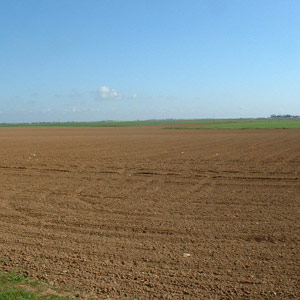Magazine | Études
Pesticides, biodiversité et populations d’oiseaux

De grandes quantités de pesticides et d’herbicides sont épandues dans les grandes zones de culture, ce qui a de graves conséquences sur la biodiversité.Photographie : Ornithomedia.com
Introduction
A l’échelle mondiale, le déclin constaté de la biodiversité est interprété, notamment par l’U.I.C.N., comme le résultat de trois causes principales : l’effet de serre, la destruction des habitats, la concurrence des espèces envahissantes introduites.
Sans nier l’importance de ces facteurs, des hypothèses alternatives, du point de vue de leurs importances respectives, peuvent être formulées. C’est le cas notamment dans les pays fortement industrialisés où la transformation des habitats sont déjà fort anciennes et alors même que les espèces des milieux bâtis se maintiennent, les populations d’espèces des milieux agricoles sont en chute spectaculaire (MNHN-IFEN).
L’hypothèse retenue dans cet article, rédigé par Christian Pacteau et François Veillerette (auteur de « Pesticides, le piège se referme »), est que, dans les pays industrialisés, l’emploi annuel de dizaines de milliers de tonnes de pesticides (notamment en France, troisième utilisateur mondial en quantité), contribue pour une très grande part à expliquer la chute récente et particulièrement brutale des effectifs des espèces tant d’oiseaux que d’amphibiens ou d’insectes.
Cet article a également été publié dans le numéro 64 de l’Oiseau Magazine.
Abstract
The worldwide decline of biodiversity is interpreted, notably by the UICN, as the result of three principal causes: the Gobal Warming, effect, the destruction of natural habitats, the competition from invading species.
Without denying the importance of these factors, alternate hypotheses can be formulated. This particularly the case notably industrialized countries where the transformation of habitats is old and where some bird populations living in agricultural environments are strongly declining.
An hypothesis is that the massive use of pesticides, notably in France (third world-wide user in quantity), contributes for a very large part to the recent and brutal fall of populations of some species of birds, amphibians and insects.
This article has been written by Christian Pacteau, a specialist in raptors breeding programs, and by François Veillerette (author of the book « Pesticides, le piège se referme »).
This article has also been published in the Oiseau Magazine (number 64).
Poursuivez la lecture de cet article, en vous abonnant dès maintenant !
Découvrez les Archives d’Ornithomedia.com
Pour seulement 10,00 €TTC/an (ou 6,00 € les 6 mois)
Profitez de plusieurs centaines d’articles en accès illimité et sans aucun engagement.
Compléments
Auteur
Christian Pacteau : pacteau.christian@wanadoo.fr
Ouvrages recommandés
- Pesticides (Broché) : le piège se referme de François Veillerette
- Oiseaux et mammifères auxiliaires des cultures hortipratic (Broché) de Jay
- Parasites : les traitements bio (Broché) de Victor Renaud
- Les pesticides dans le sol : Conséquences agronomiques et environnementales (Broché) de Raoul Calvet, Collectif
Sources
- BRGM Le Figaro 19/05/2006 – 20/05/2006
- Brown Sue Amstrong, Farmland birds and pesticides, Agriculture Policy Officer
- Cagan H Sekercioglu Université Stanford (2004) – Académie des Sciences Américaines – AFP 13/12/04
- Calvet R. & al. (2005) Les pesticides dans le sol (France Agricole)
- Campbell & al. (1997) The indirect effects of pesticides on birds
- Catriona Paul & al. (2005) Cellular and Hormonal Disruption of Fetal Testis Development in Sheep Reared on Pasture Treated with Sewage Sludge,
- Cicollela Alain (2005) Alertes Santé Fayard
- Clement E. Furlong & al. (2006) PON1 status of farmworker mothers and children as a predictor of organophosphate sensitivity
- Colborn Theo (1997) L’homme en voie de disparition
- Deborah A & al. (2005) Developmental Pesticide Models of the Parkinson Disease Phenotype
- Hayes & al. (2002). Hermaphroditic, demasculinized frogs after exposure to the herbicide, atrazine, at low ecologically relevant doses. Proceedings of the National Academy of Sciences (US) 99:5476-5480
- Hayes & al. (2006). Pesticide mixtures, endocrine disruption, and amphibian declines: Are we underestimating the impact?
- IFEN (2002) Sixième bilan annuel. Les pesticides dans les eaux
- INRA- CEMAGREF J.N. Aubertot , J.M. Barbier, A. Carpentier, J.J. Gril, L. Guichard, P.
- Lucas, S. Savary, I. Savini, M. Voltz (éditeurs), (2005). Pesticides, agriculture et environnement. Réduire l’utilisation des pesticides et limiter leurs impacts environnementaux. Expertise scientifique collective, synthèse du rapport, INRA et Cemagref (France)
- Kiesecker, JM 2002. Synergism between trematode infection and pesticide exposure: A link to amphibian limb deformities in nature? Proceedings of the National Academy of Sciences 99: 9900-9904. Liess & al. (2005) Effects of pesticides in the field
- Mesléard F. & al. « Inefficacité et effets négatifs d’un insecticide sur les invertébrés des rizières » C.R. Biologies 328 (2005)
- Mineau Pierre. (2005). Direct Losses of Birds to Pesticides Beginnings of a quantification.
- USDA Forest Service Gen. Tech. Rep. PSW-GTR-191. 2005 SETAC MNHN-IFEN (2005) Dix indicateurs de l’environnement Octobre 2005
- Newby J. A. & Howard C. V. (2006) Environmental influences in cancer aetiology
- Nielsen Hans (2005), Danish Pesticide Use Reduction Programme – to Benefit the Environment and the Health, Pesticide Policy Adviser The Danish Ecological Council Blegdamsvej 4B 2200 Copenhagen N, Denmark
- Nouzille V. (2005) Les empoisonneurs Fayard
- ONCFS (2002), Cahiers Techniques N°256, novembre 2002
- Rick A. Relyea (2005) The lethal impact of roundup on aquatic and terrestrial amphibians Ecological Applications: Vol. 15, No. 4, pp. 1118-1124
- RSPB (2005) Assessing the indirect effects of pesticides on birds PN0925 Final Report With Amendments
- Schreinemachers Dina M. (2003) Birth Malformations and Other Adverse Perinatal Outcomes in Four U.S. Wheat-Producing States
- U.S. Fish & Wildlife Service Office of Migratory Bird Management IMBD Events and information Coordinator 703/358 2318. March (2000)
- Veillerette François. (2003) Pesticides le piège se referme
- Walker C.H. (2002) Neurotoxic pesticides and behavioural effects upon birds





Aucun commentaire sur ce sujet
Participer à la discussion !